We've just added two Flash animations to the Urban Tapestries website which walk through two sample scenarios of use for public authoring.
Animation 1 has a man use UT to resolve a practical issue about mobility in the streets and in so doing has an unexpected cultural encounter.

Animation 2 has a woman use UT to remain in touch with her local neigbourhood whilst she travels abroad for a period of time.

The animations were devised by Giles Lane and Michael Golembewski and animated by Michael Golembewski.
Last Thursday Proboscis organised a one day Creative Lab at the London School of Economics exploring the theme of 'public authoring and civil society'. The Lab brought together participants from range of organisations, including (among others) Citizens Online, Community Development Foundation, Learning & Skills Council, Ordnance Survey and the University of Cambridge.
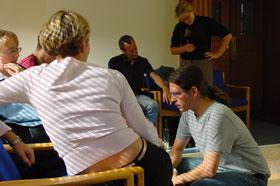
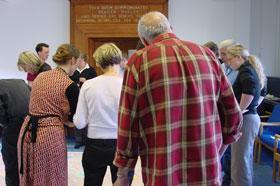
During the morning we brainstormed uses and scenarios for knowledge mapping in civil society. In the afternoon we bodystormed some of these ideas within the context of education, community arts, housing & local government interactions.
We'll be documenting the outcomes of the day over the next 2 weeks and producing an eBook to summarise the issues, ideas and scenarios arising from the day. We'll use this to help guide the development of future collaborations and experiments withing the Social Tapestries research programme.
Earlier this summer we received confirmation of an award from the Engineering & Physical Research Council (EPSRC) for a Visiting Fellowship by artist and engineer, Natalie Jeremijenko.
During the fellowship we plan to develop interfaces between reconfigured robot dogs and Urban Tapestries for hobbyists to turn consumer toys into tools for social activism – adding new sensors to detect environmental pollution and map it via UT. The aim of the research is to develop and demonstrate possibilities for people to adapt technologies for their own benefit, taking emerging technologies (like UT) and combining them with grass roots hobbyist practices for social and cultural ends.
We are very excited to be one of the first arts-based organisations to be funded by the EPSRC under its new Culture and Creativity scheme.
(30/9/2004) In fact it appears from the EPSRC's funded organisations list that Proboscis is the first such organisation (that isn't an education organisation) to be awarded funding by them.
The web browser for Urban Tapestries is nearing completion and we should be able to allow access within a few weeks. For copyright reasons users will have to register to use it. Meanwhile here's a sneak preview of the interface:
The UT Web Browser has been programmed by Michael Golembewski.
The RSS feeds from Urban Tapestries are complete and will be released with the forthcoming Web Browser. Meanwhile here's an image of a feed in NetNewsWire running on Mac OS X:
The UT RSS Feeds were programmed by Paul Makepeace.
Two views of threads created by participants in our trials:
June 2004
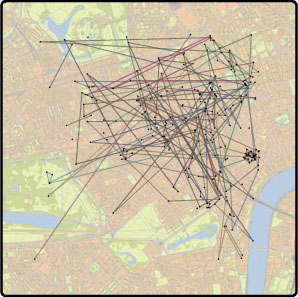
December 2003
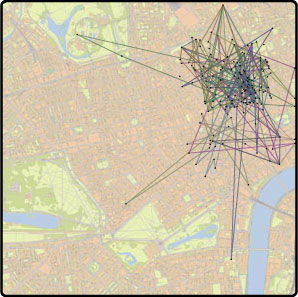
Howard Rheingold recently posted some responses to Neil Postman's 10 Principles of Technology. I've been thinking about them in relation to Urban Tapestries, Social Tapestries and what we've learnt over the past 18 months of the project.
1. All technological change is a Faustian bargain. For every advantage a new technology offers, there is always a corresponding disadvantage.
One can read this several ways – in terms of the digital divide, ecological impact of technologies, changes in social praxis and behaviours that disempower older generations – but perhaps the emphasis in the principle tends towards thinking in 19th century ideals of progress. If we seek to understand broader social practices and uses of technology, then change ceases to be a revolution replacing one system with another and moves towards being a more complementary process of augmentation. With UT and the concept of public authoring we chose to explore the relationship to place that people construct and then design a technology that assists in revealing the interconnectedness of the relationships.
2. The advantages and disadvantages of new technologies are never distributed evenly among the population. This means that every new technology benefits some and harms others.
I agree with Howard that, in general, "It's a matter of literacy" but history teaches us that literacy does not just come about without people having to strive for infrastructures to support it. With Social Tapestries one of the key aims is to design sustainable and transferable practices that do not require specific technologies, but build upon people's own capabilities.
3. Embedded in every technology there is a powerful idea, sometimes two or three powerful ideas. Like language itself, a technology predisposes us to favor and value certain perspectives and accomplishments and to subordinate others.
Yet language is constantly changing to suit the needs of people to express their situations... perspectives change with the ebb and flow of beliefs, ideologies, aspirations. I'm in favour of seeing technology in a similar light to language... it explains why there are so many lovers of 'dead' technologies, just as there are lovers of 'dead' languages. What UT and similar projects do is create a language for representing relationships to place and space, forming their own idioms and syntax. Being iterative and experimental they twist and turn, endlessly seeking to evade fixed definitions in favour of deliberate ambiguity, where each user can reconstruct their paths of meaning to suit themselves.
4. A new technology usually makes war against an old technology. It competes with it for time, attention, money, prestige and a "worldview".
Such a Darwinian concept of technology would better be served by Adam Smith's concepts of the market. Whilst it might reflect the internal pressures of the hi-tech industry I suspect that it can be challenged at the level of individual users if not more widely. People adopt technologies for many and varied reasons, primarily subject to the needs and desires of their own lives, the least of which is decided in a gladiatorial arena of warring technologies.
5. Technological change is not additive; it is ecological. A new technology does not merely add something; it changes everything.
I do not believe that technology is a driver of change but a symptom. People are the drivers of change and we (generally) get with the technologies we can best imagine using and adopting. Sometimes we surprise ourselves, but usually I think that technologies are playing catch-up with our imaginations.
6. Because of the symbolic forms in which information is encoded, different technologies have different intellectual and emotional biases.
And different cultures adopt and develop different technologies to suit their cultural inheritance.
7. Because of the accessibility and speed in which information is encoded, different technologies have different political biases.
The network effect of the internet is still only just seeping into our daily lives, pre-conditioned (as most of us older than 15 years old) are to 19th and 20th century forms of centre-to-the-margins, or broadcast, mass media. Since political ideologies have blurred to the point of relative indistinction, the bias is perhaps more an economic one. The recent struggles with peer to peer technologies and digital rights management point to the real issue being property law and what could be described as an intellectual property landgrab by those with the capital to squeeze out new entrants. Yet on the other side we see an increasing acceptance that the idea that knowledge is developed more richly in the open, shared and built upon by the many, different people adding their own unique perspectives and difference. UT is designed to support such a concept of social knowledge
8. Because of their physical form, different technologies have different sensory biases.
In the West it is clear that digital technologies have primarily served a visual sensory bias, with audio as a secondary labeit important part. Whilst much research is conducted into haptics, wearables, olfactory and other sensory interfaces, they have yet to make a serious in road into our daily lives. UT was originally developed out of our Sonic Geographies project in which we tried to imagine what sound maps of a city might be and how an deeper appreciation of the sonic environment could affect how we occupy and navigate the city. Even building in the audio location annotation functionality into UT we observed that it was hardly used in the trials – perhaps it is just a step too far for the moment and needs time to become as common as writing a note.
9. Because of the conditions in which we attend them, different technologies have different social biases.
It is not only the "conditions in which we attend them", but the social and cultural structures that affect the ways in which different technologies form part of everyday life. It would be perhaps more accurate to place the subjectivity back onto the users rather than the technology.
10. Because of their technical and economic structure, different technologies have different content biases.
Technology could be described as a set of reproducible processes – sometimes locked into physical forms. Some will be limited in terms of the kinds of content they can work with, others not. Just as a screwdriver is limited in its application to writing, and a pen to hammering nails, the issue here is perhaps accepting (and celebrating) that we need different technologies for different purposes. UT is designed to augment what people have to say about their relationships to places, things and other people, not to replace that existing communication.
On Thursday I am running a Creative Lab at the LSE on the theme of public authoring and civil society – I'm hoping there'll be some outcomes that build upon these reflections from there.
We now have a map of all the pockets and threads that the trial participants created on the system during December 2003 and June/July 2004.
A larger version can be viewed on the main UT website.
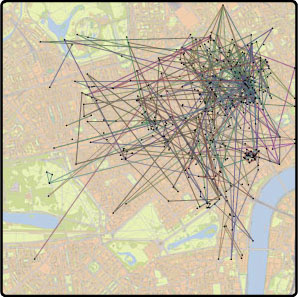
Proboscis is currently working on making the system content accessible to the general public via RSS feeds for newsreaders and a Flash Web Viewer. We are working RSS feeds that should allow people to subscribe to all new pockets on the system or to individual authors, or threads, or major towns or local areas.
The web viewer will be a graphical viewer (authoring capabilities to come in Prototype 2.0 Spring 2005) for the UT system content from the June 2004 trial, giving an insight into the possibilities of spatial annotation using high-definition mapping.
We anticipate releasing these in late September 2004 – announcements will be made here.